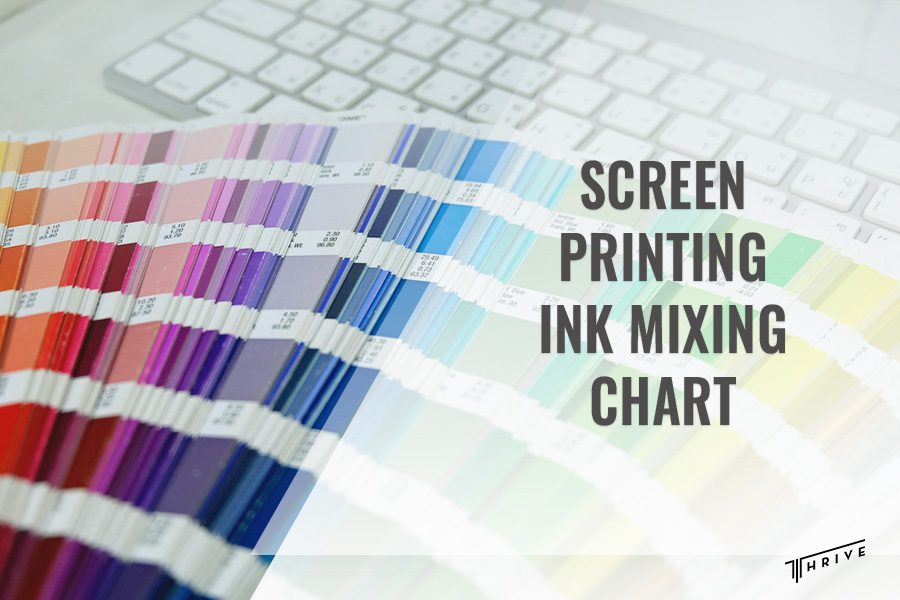
Screen printing is a versatile technique that enables you to transfer your creative artwork onto various surfaces using specialized inks. However, achieving vibrant and long-lasting designs requires careful consideration and ink mixing. This is where the screen printing ink mixing chart comes into play.
Screen printing is a blend of art and science, requiring you to consider different fabrics, inks, chemicals, and technologies to achieve exceptional print quality. In continuation, we will discuss the importance of ink-mixing charts and how they can assist you in achieving precise and consistent colors when screen printing.
Screen Printing
It is a printing technique that allows you to transfer various designs on almost any surface, including fabric, paper, glass, and wood. It enables the creation of vibrant, bold colors that are difficult to replicate with other techniques. Screen printing is versatile, fast, and cost-efficient compared to other printing methods.
When the prints are cured, they can be long-lasting without cracking or fading after repeated washing. If you want to bring your creativity and vision to life, you can elevate your prints with the best contract screen printing services. At Thrive Screen Printing, we pride ourselves on offering quality printing services.
Our skilled artisans use cutting-edge technology to create sharp, vibrant designs regardless of complexity and ensure they adhere to customer preferences. If you have just started screen printing, knowing all the details can be challenging.
Mixing Screen Printing Ink
A common question that many have regarding screen printing is — Can you mix screen-printed inks? Absolutely! However, the process requires precision and attention to detail.
Mixing inks for screen printing may be a challenging process since you need to get the right color and consistency. You can mix your prints for a successful printing run each time by preparing your workstation, using the right tools, ink mixing formulas, and practices, as well as following a screen printing ink color mixing chart.
Ink mixing formulations involve precise measurements and combinations of different base inks to achieve a specific desired color. Also, there are different types of inks for screen printing, including plastisol and water-based inks as the most common. You can make a selection based on the effects you want to achieve.
But how do you color-match screen-printed ink? We have explained it here:
- Start with a set of primary base inks along with specialty inks.
- Identify the target Pantone color code as a reference point.
- Use a color mixing chart to determine the ratios of each base ink needed to match the Pantone color.
- Measure and combine base inks based on the formulation using a scale or calibrated ink dispensers.
- Perform test prints and make adjustments if necessary by adding a little bit more of one color.
Detailed Guide on Mixing Screen Printing Ink
If you are wondering how to mix screen printing ink, follow our guide to help you get started.
1. Gather the essential materials
The first step for mixing screen printing ink is to gather the essential materials, including screen printing ink in the desired colors. Other materials needed include:
- Mixing spatula or palette knife
- Mixing surface (glass/acrylic sheet or binder)
- Measuring tool (for precise ratios)
2. Prepare the mixing surface and select the colors
After gathering the materials, prepare the mixing surface and ensure it is clean and free from dust or contaminants. Make sure you have enough space for mixing. Once this is settled, choose the base color you want to mix to achieve the desired shade.
Keep in mind that the colors you are mixing are made from other colors and mix from light to dark. Remember that mixing too many colors can lead to a muddy result.
3. Start with the base and gradually add colors
You should begin mixing by dispensing a small amount of the base colors onto the mixing surface. This will serve as a foundation for your custom shade. Then, gradually add small amounts of the secondary colors to the base.
Mix thoroughly to see how the color develops. We also recommend weighing out the colors so that once you create the desired shade, you will know how much of each color to mix. You can also experiment and create a custom ink for a unique design.
4. Check and make adjustments if necessary
While mixing ink, you can periodically check the color and compare it to your reference or desired shade. You also need to make sure that your ink consistency is right. Make adjustments by adding more ink if necessary. If you aim to reproduce a specific color, you can keep track of the ratios used.
5. Make a test print
We advise you to do a test print on a scrap piece to ensure the color is accurate and meets your expectations before printing the design. If the result is not what you wanted, you can make minor adjustments until you achieve the desired result.
What Ratio Do You Mix Ink for Screen Printing?
The ratio for mixing screen printed ink varies depending on the specific ink brand, type, and color. As a general guideline, we recommend a typical ratio of 50/50 color ratio and ink ratio to the extender base.
However, you need to keep in mind that this is a starting point. This means that if you need a more vivid color, you might need to use a less extender base. For a more subtle color, you might use more, etc.
The Significance of Screen Printing Ink Mixing Charts
The ink mixing charts are a visual reference for consistent colors across various print runs. Such a chart provides precise measurements and ratios for mixing ink pigments to make specific shades. You often need to create custom colors to match specific design requirements when you do fabric screen printing.
Moreover, an ink mixing chart provides a systematic approach to achieving accurate colors. Without a mixing chart, you may need to participate in a trial-and-error process, which can waste time and resources. Instead, a well-prepared chart may minimize mistakes and ensure efficient ink usage.
Aside from a screen printing ink mixing chart, you can also use a screen printing color mix calculator. It allows you to input the Pantone color you are aiming for and provides you with recommended ratios of base ink colors needed for achieving the shade.
Components of Ink Mixing Charts
Color codes
A screen printing ink mix chart typically includes a range of PMS color codes, which are industry-standard color references. They are often accompanied by a swatch showing the color they represent.
Pigment ratios
This type of chart also contains pigment ratios. Each color on the chart is represented by a combination of base color pigments listed with precise ratios. These rations are intended to guide you to achieve the desired shade.
Mixing instructions and measuring units
Ink mixing charts also provide measurements in various units, including weight, volume, and percentage. This enables design flexibility, enabling you to create prints based on your preferences and available equipment.
Some mixing charts contain clear instructions accompanying each color formula. It ensures the printer follows the chart accurately and creates the desired color by mixing specific amounts of ink.
Conclusion
Screen printing is a widely-used technique that includes the use of a screen printing ink mixing chart for reproducing colors with precision and consistency. Understanding and utilizing such a chart can enhance efficiency and expand your capabilities in creating custom designs.
That said, investing time in mastering the art of ink mixing is crucial for achieving professional-looking and long-lasting screen-printed products. If you are looking to transform your ideas into reality, contact us today for unparalleled printing services!

Robert Fisher is the founder and CEO of Thrive Screen Printing and brings extensive experience in the screen printing and fulfillment industry.

